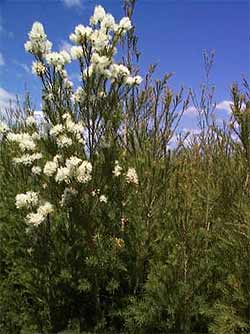Tea Tree oil: Difference between revisions
(Created page with "<html><div class="mw-content-ltr" dir="ltr" id="mw-content-text" lang="en"><p><b>Natural anti-septic oil harvested from the Melaleuca tree</b> </p> <div class="floatright"><a class="image" href="/index.php?title=File:TeaTreeOil.jpg"><img alt="TeaTreeOil.jpg" height="334" src="/images/5/57/TeaTreeOil.jpg" width="250"/></a></div> <p>Tea Tree oil is a natural anti-septic (ie. kills a broad spectrum of bacteria and fungii) harvested from the <i>Melaleuca Alternifolia</i> pla...") |
(Page conversion via llm-mediawiki-rev -jwm) |
||
| Line 1: | Line 1: | ||
'''Natural anti-septic oil harvested from the Melaleuca tree''' | |||
[[File:TeaTreeOil.jpg|right|thumb|250px|TeaTreeOil.jpg]] | |||
Tea Tree oil is a natural anti-septic (ie. kills a broad spectrum of bacteria and fungii) harvested from the ''Melaleuca Alternifolia'' plant native to the New South Wales region of Australia. It is an excellent topical first aid solution which is safe for most healing wounds (it has even been used to clean open surgical wounds). Because it is also a powerful organic solvent, it is able to dissolve white blood cells and pus inside a wound (allowing the tissue to heal with minimal scarring). This solvent nature also gives it its penetrative qualities. | |||
Historically the Bundjalung aborigines used the substance, and viewed the lagoon where the leaves fell and spend hundreds of years decaying as being a magical place of healing. In the early 1900s, mainstream Australian surgeons began using the oil for wound treatment, noting it to have remarkable penetration with minimal irritation (most germicides destroy tissue as well as germs). In World War II, tea tree oil was even issued to soldiers as part of their first aid kits. Tea tree oil is commonly used by midwives and other professionals peripheral to the medical industry. | |||
It should also be mentioned that there has been some success in using tea tree oil to combat modern drug resistant bacteria. | |||
Finally, the plants grow quickly, are a renewable resource, and can be harvested with minimal damage to the environment. | |||
Please note that there is some evidence that tea tree oil is a CNS depressant, and you shouldn't be drinking it! (Although Captain Cook, who is credited with naming "Tea Tree" in 1770 when he brewed a tea from the leaves for his sailors to ward off scurvy). It is poisonous to cats. | |||
== Risks == | |||
Like herbal remedies, caution needs to used when using as [[Piercing|piercing]] [[Aftercare|aftercare]]. Regulations controlling the contents of herbal medications can be lax or non existent, meaning the contents can vary from one bottle to another. Of course, many companies impose strict guidelines on themselves and provide consistent quality. Purchase for quality, not price. | |||
While it can be healthy applied to the skin, tea tree oil is toxic if ingested. As many warning labels bottles will point out it this may result in ''dizziness, nausea'' and ''disorientation''. | |||
Latest revision as of 19:10, 25 September 2023
Natural anti-septic oil harvested from the Melaleuca tree
Tea Tree oil is a natural anti-septic (ie. kills a broad spectrum of bacteria and fungii) harvested from the Melaleuca Alternifolia plant native to the New South Wales region of Australia. It is an excellent topical first aid solution which is safe for most healing wounds (it has even been used to clean open surgical wounds). Because it is also a powerful organic solvent, it is able to dissolve white blood cells and pus inside a wound (allowing the tissue to heal with minimal scarring). This solvent nature also gives it its penetrative qualities.
Historically the Bundjalung aborigines used the substance, and viewed the lagoon where the leaves fell and spend hundreds of years decaying as being a magical place of healing. In the early 1900s, mainstream Australian surgeons began using the oil for wound treatment, noting it to have remarkable penetration with minimal irritation (most germicides destroy tissue as well as germs). In World War II, tea tree oil was even issued to soldiers as part of their first aid kits. Tea tree oil is commonly used by midwives and other professionals peripheral to the medical industry.
It should also be mentioned that there has been some success in using tea tree oil to combat modern drug resistant bacteria.
Finally, the plants grow quickly, are a renewable resource, and can be harvested with minimal damage to the environment.
Please note that there is some evidence that tea tree oil is a CNS depressant, and you shouldn't be drinking it! (Although Captain Cook, who is credited with naming "Tea Tree" in 1770 when he brewed a tea from the leaves for his sailors to ward off scurvy). It is poisonous to cats.
Risks
Like herbal remedies, caution needs to used when using as piercing aftercare. Regulations controlling the contents of herbal medications can be lax or non existent, meaning the contents can vary from one bottle to another. Of course, many companies impose strict guidelines on themselves and provide consistent quality. Purchase for quality, not price. While it can be healthy applied to the skin, tea tree oil is toxic if ingested. As many warning labels bottles will point out it this may result in dizziness, nausea and disorientation.
